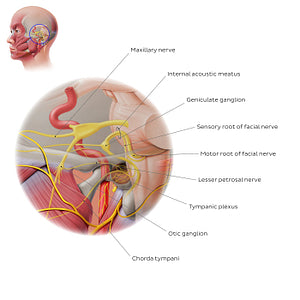Paul Kim
Facial nerve: intracranial/intratemporal parts (English)
Facial nerve: intracranial/intratemporal parts (English)
The larger and more medial motor root as well as the smaller, more lateral, sensory root (intermediate nerve) arise at the cerebellopontine angle and traverse the posterior cranial fossa, forming the intracranial part of the facial nerve. The roots then enter the temporal bone via the internal acoustic meatus together with the vestibulocochlear nerve, as well as the labyrinthine artery and vein. The sensory and motor components usually merge at, or within the internal acoustic meatus, and then continue into the facial canal located along the medial wall of the tympanic cavity. Here, the facial nerve expands into the geniculate ganglion, which contains the cell bodies of the sensory neurons related to the nerve. The greater petrosal nerve arises directly from the geniculate ganglion and carries general visceral efferent (parasympathetic) fibers destined for the lacrimal, nasal and palatine glands, as well as special visceral afferent (taste) fibers from the palate (both via the pterygopalatine ganglion). The facial nerve then gives off two further intratemporal branches (nerve to stapedius muscle and the chorda tympani) which arise before the facial nerve exits the temporal bone via the stylomastoid foramen. The chorda tympani carries both parasympathetic fibers destined for the submandibular/sublingual glands as well as special visceral afferent (taste) fibers from the anterior two-thirds of the tongue via the lingual nerve (see next image).
Normaler Preis
$7.56 USD
Normaler Preis
Verkaufspreis
$7.56 USD
Grundpreis
pro
Verfügbarkeit für Abholungen konnte nicht geladen werden


#F7D725
#A15959
#662520
#4D3028
#E1CBA3 und #D5B6A9

